The Versatile Applications of Calix[4]resorcinarene-Based Cavitands
Abstract
1. Introduction
2. Catalysis
3. Separation and Purification
4. Polymeric Materials
5. Sensing
6. Battery Materials
7. Drug Delivery
8. Conclusions
Author Contributions
Funding
Acknowledgments
Conflicts of Interest
References
- Wang, K.; Liu, Q.; Zhou, L.; Sun, H.; Yao, X.; Hu, X.-Y. State-of-the-art and Recent Progress in Resorcinarene-based Cavitand. Chin. Chem. Lett. 2023, 34, 108559. [Google Scholar] [CrossRef]
- Escobar, L.; Ballester, P. Molecular Recognition in Water Using Macrocyclic Synthetic Receptors. Chem. Rev. 2021, 121, 2445–2514. [Google Scholar] [CrossRef] [PubMed]
- Wang, K.; Jordan, J.H.; Hu, X.Y.; Wang, L. Supramolecular Strategies for Controlling Reactivity within Confined Nanospaces. Angew. Chem. Int. Ed. 2020, 59, 13712–13721. [Google Scholar] [CrossRef] [PubMed]
- Bai, Z.; Velmurugan, K.; Tian, X.; Zuo, M.; Wang, K.; Hu, X.Y. Tetraphenylethylene-embedded Pillar[5]arene-based Orthogonal Self-assembly for Efficient Photocatalysis in Water. Beilstein. J. Org. Chem. 2022, 18, 429–437. [Google Scholar] [CrossRef]
- Carnegie, R.S.; Gibb, C.L.; Gibb, B.C. Anion Complexation and the Hofmeister Effect. Angew. Chem. Int. Ed. 2014, 53, 11498–11500. [Google Scholar] [CrossRef]
- Wang, K.; Zuo, M.; Zhang, T.; Yue, H.; Hu, X.-Y. Pillar[5]arene–modified Peptide-guanidiniocarbonylpyrrol Amphiphiles with Gene Transfection Properties. Chin. Chem. Lett. 2023, 34, 107848. [Google Scholar] [CrossRef]
- Xiao, Z.; Liu, Y.; Niu, Y.; Kou, X. Cyclodextrin Supermolecules as Excellent Stabilizers for Pickering Nanoemulsions. Colloids Surf. A Physicochem. Eng. Asp. 2020, 588, 124367. [Google Scholar] [CrossRef]
- Zhang, Y.F.; Di, F.F.; Li, P.F.; Xiong, R.G. Crown Ether Host-Guest Molecular Ferroelectrics. Chemistry 2022, 28, e202102990. [Google Scholar] [CrossRef] [PubMed]
- Pan, Y.C.; Hu, X.Y.; Guo, D.S. Biomedical Applications of Calixarenes: State of the Art and Perspectives. Angew. Chem. Int. Ed. 2021, 60, 2768–2794. [Google Scholar] [CrossRef] [PubMed]
- Chen, Y.-Q.; Guan, H.-W.; Kanagaraj, K.; Rebek, J.; Yu, Y. Metal Coordination to a Deep Cavitand Promotes Binding Selectivities in Water. Chin. Chem. Lett. 2022, 33, 4908–4911. [Google Scholar] [CrossRef]
- Hillyer, M.B.; Gibb, C.L.; Sokkalingam, P.; Jordan, J.H.; Ioup, S.E.; Mague, J.T.; Gibb, B.C. Synthesis of Water-Soluble Deep-Cavity Cavitands. Org. Lett. 2016, 18, 4048–4051. [Google Scholar] [CrossRef] [PubMed]
- Kanagaraj, K.; Wang, R.; Zhao, M.K.; Ballester, P.; Rebek, J., Jr.; Yu, Y. Selective Binding and Isomerization of Oximes in a Self-Assembled Capsule. J. Am. Chem. Soc. 2023, 145, 5816–5823. [Google Scholar] [CrossRef] [PubMed]
- Wan, Y.H.; Zhu, Y.J.; Rebek, J., Jr.; Yu, Y. Recognition of Hydrophilic Cyclic Compounds by a Water-Soluble Cavitand. Molecules 2021, 26, 1922. [Google Scholar] [CrossRef]
- Tang, M.M.; Kanagaraj, K.; Rebek, J., Jr.; Yu, Y. Role of Rim Functions in Recognition and Selectivity of Small-Molecule Guests in Water-Soluble Cavitand Hosts. Chem. Asian. J. 2022, 17, e202200466. [Google Scholar] [CrossRef] [PubMed]
- Wang, K.; Cai, X.; Yao, W.; Tang, D.; Kataria, R.; Ashbaugh, H.S.; Byers, L.D.; Gibb, B.C. Electrostatic Control of Macrocyclization Reactions within Nanospaces. J. Am. Chem. Soc. 2019, 141, 6740–6747. [Google Scholar] [CrossRef]
- Wang, K.; Gibb, B.C. Mapping the Binding Motifs of Deprotonated Monounsaturated Fatty Acids and Their Corresponding Methyl Esters within Supramolecular Capsules. J. Org. Chem. 2017, 82, 4279–4288. [Google Scholar] [CrossRef]
- Bourgeois, J.M.; Stoeckli-Evans, H. Synthesis of New Resorcinarenes Under Alkaline Conditions. Helv. Chimica Acta 2005, 88, 2722–2730. [Google Scholar] [CrossRef]
- Hahn, D.F.; Milić, J.V.; Hünenberger, P.H. Vase-Kite Equilibrium of Resorcin[4]arene Cavitands Investigated Using Molecular Dynamics Simulations with Ball-and-Stick Local Elevation Umbrella Sampling. Helv. Chimica Acta 2019, 102, e1900060. [Google Scholar] [CrossRef]
- Aroua, S.; Lowell, A.N.; Ray, A.; Trapp, N.; Schweizer, W.B.; Ebert, M.O.; Yamakoshi, Y. Larger Substituents on Amide Cavitands Induce Bigger Cavities. Org. Lett. 2019, 21, 201–205. [Google Scholar] [CrossRef]
- Zhu, Y.J.; Gao, Y.; Tang, M.M.; Rebek, J.; Yu, Y. Dimeric Capsules Self-assembled through Halogen and Chalcogen Bonding. Chem. Commun. 2021, 57, 1543–1549. [Google Scholar] [CrossRef]
- Velpuri, S.V.V.; Gade, H.M.; Wanjari, P.P. Encapsulation Driven Conformational Changes in N-alkanes inside a Hydrogen-bonded Supramolecular Cavitand Assembly. Chem. Phys. 2019, 521, 100–107. [Google Scholar] [CrossRef]
- Guan, H.W.; Zhu, Y.J.; Peters, J.; Brea, O.; Himo, F.; Rebek, J.; Yu, Y. Recognition of Hydrophilic Molecules in Deep Cavitand Hosts with Water-mediated Hydrogen Bonds. Chem. Commun. 2021, 57, 8147–8150. [Google Scholar] [CrossRef] [PubMed]
- Aakeroy, C.B.; Rajbanshi, A.; Desper, J. Hydrogen-bond Driven Assembly of a Molecular Capsule Facilitated by Supramolecular Chelation. Chem. Commun. 2011, 47, 11411–11413. [Google Scholar] [CrossRef] [PubMed]
- Zhang, H.B.; Kanagaraj, K.; Rebek, J., Jr.; Yu, Y. Hydrophobic and Metal-Coordinated Confinement Effects Trigger Recognition and Selectivity. J. Org. Chem. 2021, 86, 8873–8881. [Google Scholar] [CrossRef] [PubMed]
- Rahman, F.U.; Tzeli, D.; Petsalakis, I.D.; Theodorakopoulos, G.; Ballester, P.; Rebek, J., Jr.; Yu, Y. Chalcogen Bonding and Hydrophobic Effects Force Molecules into Small Spaces. J. Am. Chem. Soc. 2020, 142, 5876–5883. [Google Scholar] [CrossRef]
- Zhu, Y.; Tang, M.; Zhang, H.; Rahman, F.U.; Ballester, P.; Rebek, J., Jr.; Hunter, C.A.; Yu, Y. Water and the Cation-pi Interaction. J. Am. Chem. Soc. 2021, 143, 12397–12403. [Google Scholar] [CrossRef]
- Smith, J.N.; Ennis, C.; Lucas, N.T. Rigid, Biconical Hydrogen-bonded Dimers that Strongly Encapsulate Cationic Guests in Solution and the Solid State. Chem. Sci. 2021, 12, 11858–11863. [Google Scholar] [CrossRef]
- Rahman, F.-U.; Feng, H.-N.; Yu, Y. A new Water-soluble Cavitand with Deeper Guest Binding Properties. Org. Chem. Front. 2019, 6, 998–1001. [Google Scholar] [CrossRef]
- Omeroglu, I.; Tumay, S.O.; Makhseed, S.; Husain, A.; Durmus, M. A highly Sensitive “ON-OFF-ON” Dual Optical Sensor for the Detection of Cu(II) ion and Triazole Pesticides based on Novel BODIPY-substituted Cavitand. Dalton. Trans. 2021, 50, 6437–6443. [Google Scholar] [CrossRef]
- Jordan, J.H.; Gibb, C.L.D.; Tran, T.; Yao, W.; Rose, A.; Mague, J.T.; Easson, M.W.; Gibb, B.C. Anion Binding to Ammonium and Guanidinium Hosts: Implications for the Reverse Hofmeister Effects Induced by Lysine and Arginine Residues. J. Org. Chem. 2024, 89, 6877–6891. [Google Scholar] [CrossRef]
- Bibal, B.; Tinant, B.; Declercq, J.P.; Dutasta, J.P. A New Supramolecular Assembly Obtained from the Combination of Silver(I) Cations with a Thiophosphorylated Cavitand. Chem. Commun. 2002, 5, 432–433. [Google Scholar] [CrossRef] [PubMed]
- Zuccaccia, D.; Pinalli, R.; De Zorzi, R.; Semeraro, M.; Credi, A.; Zuccaccia, C.; Macchioni, A.; Geremia, S.; Dalcanale, E. Hierarchical Self-assembly and Controlled Disassembly of a Cavitand-based Host–guest Supramolecular Polymer. Polym. Chem. 2021, 12, 389–401. [Google Scholar] [CrossRef]
- Riwar, L.J.; Trapp, N.; Root, K.; Zenobi, R.; Diederich, F. Supramolecular Capsules: Strong versus Weak Chalcogen Bonding. Angew. Chem. Int. Ed. 2018, 57, 17259–17264. [Google Scholar] [CrossRef] [PubMed]
- Grajda, M.; Lewinska, M.J.; Szumna, A. The Templation Effect as a Driving Force for the Self-assembly of Hydrogen-bonded Peptidic Capsules in Competitive Media. Org. Biomol. Chem. 2017, 15, 8513–8517. [Google Scholar] [CrossRef]
- Sierra, A.F.; Aragay, G.; Peñuelas-Haro, G.; Ballester, P. Supramolecular Fluorescence Sensing of l-proline and l-pipecolic acid. Org. Chem. Front. 2021, 8, 2402–2412. [Google Scholar] [CrossRef]
- Thomas, S.S.; Tang, H.; Gaudes, A.; Baggesen, S.B.; Gibb, C.L.D.; Gibb, B.C.; Bohne, C. Tuning the Binding Dynamics of a Guest-Octaacid Capsule through Noncovalent Anchoring. J. Phys. Chem. Lett. 2017, 8, 2573–2578. [Google Scholar] [CrossRef]
- Liu, Y.; Lee, J.; Perez, L.; Gill, A.D.; Hooley, R.J.; Zhong, W. Selective Sensing of Phosphorylated Peptides and Monitoring Kinase and Phosphatase Activity with a Supramolecular Tandem Assay. J. Am. Chem. Soc. 2018, 140, 13869–13877. [Google Scholar] [CrossRef]
- Mirzaei, S.; Espinoza Castro, V.M.; Hernandez Sanchez, R. Nonspherical Anion Sequestration by C-H Hydrogen Bonding. Chem. Sci. 2022, 13, 2026–2032. [Google Scholar] [CrossRef]
- Vidal, D.; Costas, M.; Lledó, A. A Deep Cavitand Receptor Functionalized with Fe(II) and Mn(II) Aminopyridine Complexes for Bioinspired Oxidation Catalysis. ACS Catal. 2018, 8, 3667–3672. [Google Scholar] [CrossRef]
- Park, Y.S.; Kim, J.W.; Paek, K. Molecular capsules of tetrakis(N-hydantoinylimino)cavitand: Selective Encapsulation of 1,4-diiodobenzene. Tetrahedron Lett. 2017, 58, 3366–3369. [Google Scholar] [CrossRef]
- Nagymihály, Z.; Csók, Z.; Kollár, L. Influence of base Additives on the Selectivity of Palladium-catalysed Aminocarbonylation: Highly Selective Functionalization of a Cavitand Scaffold. Mol. Catal. 2018, 444, 70–75. [Google Scholar] [CrossRef]
- Milić, J.V.; Schneeberger, T.; Zalibera, M.; Milowska, K.Z.; Ong, Q.K.; Trapp, N.; Ruhlmann, L.; Boudon, C.; Thilgen, C.; Diederich, F. Thioether-Functionalized Quinone-Based Resorcin[4]arene Cavitands: Electroswitchable Molecular Actuators. Helv. Chimica Acta 2019, 102, e1800225. [Google Scholar] [CrossRef]
- Gropp, C.; Quigley, B.L.; Diederich, F. Molecular Recognition with Resorcin[4]arene Cavitands: Switching, Halogen-Bonded Capsules, and Enantioselective Complexation. J. Am. Chem. Soc. 2018, 140, 2705–2717. [Google Scholar] [CrossRef]
- Lledó, A.; Soler, A. Binding of Ion Pairs in a Thiourea-functionalized Self-folding Cavitand. Org. Chem. Front. 2017, 4, 1244–1249. [Google Scholar] [CrossRef]
- Liu, S.; Gibb, B.C. Solvent Denaturation of Supramolecular Capsules Assembled via the Hydrophobic Effect. Chem. Commun. 2011, 47, 3574–3576. [Google Scholar] [CrossRef]
- Knighton, R.C.; Chaplin, A.B. Synthesis, Structure and Binding Properties of a Series of Dissymmetric Resorcin[4]arene-based Cavitands. Tetrahedron 2017, 73, 4591–4596. [Google Scholar] [CrossRef]
- Pan, F.; Beyeh, N.K.; Rissanen, K. Concerted Halogen-Bonded Networks with N-Alkyl Ammonium Resorcinarene Bromides: From Dimeric Dumbbell to Capsular Architectures. J. Am. Chem. Soc. 2015, 137, 10406–10413. [Google Scholar] [CrossRef]
- Liu, Y.; Perez, L.; Mettry, M.; Easley, C.J.; Hooley, R.J.; Zhong, W. Self-Aggregating Deep Cavitand Acts as a Fluorescence Displacement Sensor for Lysine Methylation. J. Am. Chem. Soc. 2016, 138, 10746–10749. [Google Scholar] [CrossRef] [PubMed]
- Hooley, R.J.; Biros, S.M.; Rebek, J., Jr. A Deep, Water-soluble Cavitand Acts as a Phase-transfer Catalyst for Hydrophobic species. Angew. Chem. Int. Ed. 2006, 45, 3517–3519. [Google Scholar] [CrossRef]
- Gropp, C.; Trapp, N.; Diederich, F. Alleno-Acetylenic Cage (AAC) Receptors: Chiroptical Switching and Enantioselective Complexation of trans-1,2-Dimethylcyclohexane in a Diaxial Conformation. Angew. Chem. Int. Ed. 2016, 55, 14444–14449. [Google Scholar] [CrossRef]
- Ciardi, M.; Galan, A.; Ballester, P. Tetra-phosphonate Calix[4]pyrrole Cavitands as Multitopic Receptors for the Recognition of Ion Pairs. J. Am. Chem. Soc. 2015, 137, 2047–2055. [Google Scholar] [CrossRef] [PubMed]
- Azov, V.A.; Schlegel, A.; Diederich, F. Geometrically Precisely Defined Multinanometer Expansion/contraction Motions in a Resorcin[4]arene Cavitand based Molecular Switch. Angew. Chem. Int. Ed. 2005, 44, 4635–4638. [Google Scholar] [CrossRef] [PubMed]
- Wang, K.; Shen, Y.; Jeyakkumar, P.; Zhang, Y.; Chu, L.; Zhang, R.; Hu, X.-Y. Supramolecular artificial Light-harvesting Systems for Photocatalysis. Curr. Opin. Green Sustain. Chem. 2023, 41, 100823. [Google Scholar] [CrossRef]
- Sultanova, E.D.; Nizameev, I.R.; Kholin, K.V.; Kadirov, M.K.; Ovsyannikov, A.S.; Burilov, V.A.; Ziganshina, A.Y.; Antipin, I.S. Photocatalytic Properties of Hybrid Materials Based on a Multicharged Polymer Matrix with Encored TiO2 and Noble Metal (Pt, Pd or Au) Nanoparticles. New J. Chem. 2020, 44, 7169–7174. [Google Scholar] [CrossRef]
- Sokolova, D.; Piccini, G.; Tiefenbacher, K. Enantioselective Tail-to-Head Terpene Cyclizations by Optically Active Hexameric Resorcin[4]arene Capsule Derivatives. Angew. Chem. Int. Ed. 2022, 61, e202203384. [Google Scholar] [CrossRef]
- De Rosa, M.; Gambaro, S.; Soriente, A.; Della Sala, P.; Iuliano, V.; Talotta, C.; Gaeta, C.; Rescifina, A.; Neri, P. Carbocation Catalysis in Confined Space: Activation of Trityl Chloride inside the Hexameric Resorcinarene Capsule. Chem. Sci. 2022, 13, 8618–8625. [Google Scholar] [CrossRef]
- Bordignon, F.; Calmanti, R.; Perosa, A.; Fabris, F.; Scarso, A. Confinement Effects in Catalysis: Steering the Product Selectivity in Cannabidiol Isomerization by the Resorcinarene Supramolecular Capsule. ChemCatChem 2024, 16, e202400278. [Google Scholar] [CrossRef]
- Petroselli, M.; Chen, Y.-Q.; Zhao, M.-K.; Rebek, J.; Yu, Y. C-H⋅⋅⋅X-C Bonds in Alkyl halides Drive Reverse Selectivities in Confined Spaces. Chin. Chem. Lett. 2023, 34, 107834. [Google Scholar] [CrossRef]
- Petroselli, M.; Rebek, J., Jr.; Yu, Y. Highly Selective Radical Monoreduction of Dihalides Confined to a Dynamic Supramolecular Host. Chemistry 2021, 27, 3284–3287. [Google Scholar] [CrossRef]
- Shi, Q.; Masseroni, D.; Rebek, J., Jr. Macrocyclization of Folded Diamines in Cavitands. J. Am. Chem. Soc. 2016, 138, 10846–10848. [Google Scholar] [CrossRef]
- Martin-Torres, I.; Ogalla, G.; Yang, J.M.; Rinaldi, A.; Echavarren, A.M. Enantioselective Alkoxycyclization of 1,6-Enynes with Gold(I)-Cavitands: Total Synthesis of Mafaicheenamine C. Angew. Chem. Int. Ed. 2021, 60, 9339–9344. [Google Scholar] [CrossRef] [PubMed]
- Liu, Q.; Zuo, M.; Wang, K.; Hu, X.Y. A Cavitand-based Supramolecular Artificial Light-harvesting System with Sequential Energy Transfer for Photocatalysis. Chem. Commun. 2023, 59, 13707–13710. [Google Scholar] [CrossRef] [PubMed]
- Song, Y.; Xiao, Y.; Pei, W.-Y.; Zhang, J.-Y.; Liu, C.; Ma, J.-F. A Calix[4]resorcinarene-Copper(II) Based Supramolecular Nanocapsule with Encapsulated Polyoxometalates for Enhanced Photocatalytic Activity. ACS Appl. Nano Mater. 2023, 6, 11902–11911. [Google Scholar] [CrossRef]
- Sato, K.; Sasaki, R.; Matsuda, R.; Nakagawa, M.; Ekimoto, T.; Yamane, T.; Ikeguchi, M.; Tabata, K.V.; Noji, H.; Kinbara, K. Supramolecular Mechanosensitive Potassium Channel Formed by Fluorinated Amphiphilic Cyclophane. J. Am. Chem. Soc. 2022, 144, 11802–11809. [Google Scholar] [CrossRef] [PubMed]
- Zhang, H.; Ye, R.; Mu, Y.; Li, T.; Zeng, H. Small Molecule-Based Highly Active and Selective K(+) Transporters with Potent Anticancer Activities. Nano Lett. 2021, 21, 1384–1391. [Google Scholar] [CrossRef]
- Wan, Y.H.; Rahman, F.U.; Rebek, J.; Yu, Y. Shape Selectivity of a Metallo Cavitand Host Allows Separation of n-Alkanes from Isooctane. Chin. J. Chem. 2021, 39, 1498–1502. [Google Scholar] [CrossRef]
- Yang, Y.; Cheng, K.; Lu, Y.; Ma, D.; Shi, D.; Sun, Y.; Yang, M.; Li, J.; Wei, J. A Polyaromatic Nano-nest for Hosting Fullerenes C(60) and C(70). Org. Lett. 2018, 20, 2138–2142. [Google Scholar] [CrossRef]
- Samanta, J.; Tang, M.; Zhang, M.; Hughes, R.P.; Staples, R.J.; Ke, C. Tripodal Organic Cages with Unconventional CH...O Interactions for Perchlorate Remediation in Water. J. Am. Chem. Soc. 2023, 145, 21723–21728. [Google Scholar] [CrossRef]
- Chen, S.-Q.; Yu, S.-N.; Zhao, W.; Liang, L.; Gong, Y.; Yuan, L.; Tang, J.; Yang, X.-J.; Wu, B. Recognition-guided sulfate extraction and transport using tripodal hexaurea receptors. Inorg. Chem. Front. 2022, 9, 6091–6101. [Google Scholar] [CrossRef]
- Chen, S.Q.; Zhao, W.; Wu, B. Separation of Sulfate Anion From Aqueous Solution Governed by Recognition Chemistry: A Minireview. Front. Chem. 2022, 10, 905563. [Google Scholar] [CrossRef]
- Giri, G.; Hussain, M.D.W.; Sk, B.; Patra, A. Connecting the Dots: Knitting C-Phenylresorcin[4]arenes with Aromatic Linkers for Task-Specific Porous Organic Polymers. Chem. Mater. 2019, 31, 8440–8450. [Google Scholar] [CrossRef]
- Amorini, M.; Riboni, N.; Pesenti, L.; Dini, V.A.; Pedrini, A.; Massera, C.; Gualandi, C.; Bianchi, F.; Pinalli, R.; Dalcanale, E. Reusable Cavitand-Based Electrospun Membranes for the Removal of Polycyclic Aromatic Hydrocarbons from Water. Small 2022, 18, e2104946. [Google Scholar] [CrossRef] [PubMed]
- Skala, L.P.; Yang, A.; Klemes, M.J.; Xiao, L.; Dichtel, W.R. Resorcinarene Cavitand Polymers for the Remediation of Halomethanes and 1,4-Dioxane. J. Am. Chem. Soc. 2019, 141, 13315–13319. [Google Scholar] [CrossRef]
- Xiao, Q.; Wang, H.; Wang, L.; Diao, J.; Zhao, L.; He, G.; Wang, T.; Jiang, X. Interfacial Modification of Hydrogel Composite Membranes for Protein Adsorption with Cavitands as Nano Molecular Containers. Sep. Purif. Technol. 2024, 339, 126438. [Google Scholar] [CrossRef]
- Ryvlin, D.; Dumele, O.; Linke, A.; Fankhauser, D.; Schweizer, W.B.; Diederich, F.; Waldvogel, S.R. Systematic Investigation of Resorcin[4]arene-Based Cavitands as Affinity Materials on Quartz Crystal Microbalances. Chempluschem 2017, 82, 493–497. [Google Scholar] [CrossRef]
- Kane, C.M.; Ugono, O.; Barbour, L.J.; Holman, K.T. Many Simple Molecular Cavitands Are Intrinsically Porous (Zero-Dimensional Pore) Materials. Chem. Mater. 2015, 27, 7337–7354. [Google Scholar] [CrossRef]
- Giri, A.; Sahoo, A.; Dutta, T.K.; Patra, A. Cavitand and Molecular Cage-Based Porous Organic Polymers. ACS Omega 2020, 5, 28413–28424. [Google Scholar] [CrossRef]
- Biedermann, F.; De Cola, L. Porous Supramolecular Materials: The Importance of Emptiness. Supramol. Chem. 2018, 30, 166–168. [Google Scholar] [CrossRef]
- Nitta, N.; Takatsuka, M.; Kihara, S.I.; Hirao, T.; Haino, T. Self-Healing Supramolecular Materials Constructed by Copolymerization via Molecular Recognition of Cavitand-Based Coordination Capsules. Angew. Chem. Int. Ed. 2020, 59, 16690–16697. [Google Scholar] [CrossRef]
- Portone, F.; Amorini, M.; Montanari, M.; Pinalli, R.; Pedrini, A.; Verucchi, R.; Brighenti, R.; Dalcanale, E. Molecular Auxetic Polymer of Intrinsic Microporosity via Conformational Switching of a Cavitand Crosslinker. Adv. Funct. Mater. 2023, 33, 2307605. [Google Scholar] [CrossRef]
- Pinalli, R.; Pedrini, A.; Dalcanale, E. Environmental Gas Sensing with Cavitands. Chemistry 2018, 24, 1010–1019. [Google Scholar] [CrossRef] [PubMed]
- Gilmullina, Z.R.; Syakaev, V.V.; Morozova, J.E.; Ziganshina, A.Y.; Antipin, I.S. The Interaction of Rhodamine B with Sulfobetaine Tetrapentylcalix[4]resorcinarene in the Range of Millimolar Concentrations. J. Incl. Phenom. Macrocycl. Chem. 2024, 104, 449–459. [Google Scholar] [CrossRef]
- Liu, Y.; Mettry, M.; Gill, A.D.; Perez, L.; Zhong, W.; Hooley, R.J. Selective Heavy Element Sensing with a Simple Host-Guest Fluorescent Array. Anal. Chem. 2017, 89, 11113–11121. [Google Scholar] [CrossRef] [PubMed]
- Chen, J.; Fasihianifard, P.; Raz, A.A.P.; Hickey, B.L.; Moreno, J.L., Jr.; Chang, C.A.; Hooley, R.J.; Zhong, W. Selective Recognition and Discrimination of Single Isomeric Changes in Peptide Strands with a Host: Guest Sensing Array. Chem. Sci. 2024, 15, 1885–1893. [Google Scholar] [CrossRef]
- Rozzi, A.; Pedrini, A.; Pinalli, R.; Cozzani, E.; Elmi, I.; Zampolli, S.; Dalcanale, E. Cavitand Decorated Silica as a Selective Preconcentrator for BTEX Sensing in Air. Nanomaterials 2022, 12, 2204. [Google Scholar] [CrossRef] [PubMed]
- Hickey, B.L.; Chen, J.; Zou, Y.; Gill, A.D.; Zhong, W.; Millar, J.G.; Hooley, R.J. Enantioselective Sensing of Insect Pheromones in Water. Chem. Commun. 2021, 57, 13341–13344. [Google Scholar] [CrossRef]
- Clément, P.; Korom, S.; Struzzi, C.; Parra, E.J.; Bittencourt, C.; Ballester, P.; Llobet, E. Deep Cavitand Self-Assembled on Au NPs-MWCNT as Highly Sensitive Benzene Sensing Interface. Adv. Funct. Mater. 2015, 25, 4011–4020. [Google Scholar] [CrossRef]
- Chen, J.; Hickey, B.L.; Wang, L.; Lee, J.; Gill, A.D.; Favero, A.; Pinalli, R.; Dalcanale, E.; Hooley, R.J.; Zhong, W. Selective Discrimination and Classification of G-quadruplex Structures with a Host-guest Sensing Array. Nat. Chem. 2021, 13, 488–495. [Google Scholar] [CrossRef] [PubMed]
- Chen, J.; Tabaie, E.Z.; Hickey, B.L.; Gao, Z.; Raz, A.A.P.; Li, Z.; Wilson, E.H.; Hooley, R.J.; Zhong, W. Selective Molecular Recognition and Indicator Displacement Sensing of Neurotransmitters in Cellular Environments. ACS Sens. 2023, 8, 3195–3204. [Google Scholar] [CrossRef]
- Yang, Y.; Chen, Z.; Lv, T.; Dong, K.; Liu, Y.; Qi, Y.; Cao, S.; Chen, T. Ultrafast Self-assembly of Supramolecular Hydrogels toward Novel Flame-retardant Separator for Safe Lithium Iion Battery. J. Colloid Interface Sci. 2023, 649, 591–600. [Google Scholar] [CrossRef]
- Tang, G.; Shen, S.-P.; Li, H.-J.; Zhang, L.; Zheng, J.-C.; Luo, Y.; Yue, J.-P.; Shi, Y.; Chen, Z. Flame-Retardant Gel Electrolyte toward High-Safety Lithium Metal Batteries with High-Mass-Loading Cathodes. J. Phys. Chem. C 2023, 127, 9463–9470. [Google Scholar] [CrossRef]
- Zhou, J.; Meng, Y.; Shen, D.; Zhou, Y.; Liu, J.; Cao, Y.; Yan, C.; Qian, T. Empowering Quasi-solid Electrolyte with Smart Thermoresistance and Damage Repairability to Realize Safer Lithium Metal Batteries. J. Phys. Chem. Lett. 2023, 14, 4482–4489. [Google Scholar] [CrossRef] [PubMed]
- Yu, M.-Y.; Liu, J.-H.; Yang, J.; Ma, J.-F. A family of polyoxometalate-resorcin[4]arene-based Metal–organic Materials: Assemblies, Structures and Lithium Ion Battery Properties. J. Alloys Compd. 2021, 868, 159009. [Google Scholar] [CrossRef]
- Liu, J.-H.; Yu, M.-Y.; Yang, J.; Liu, Y.-Y.; Ma, J.-F. Polyoxometalate-based Complex/graphene for High-rate Lithium-ion Batteries. Micropor. Mesopor. Mater. 2021, 310, 110666. [Google Scholar] [CrossRef]
- Sun, G.; Zuo, M.; Xu, Z.; Wang, K.; Wang, L.; Hu, X.Y. Orthogonal Design of Supramolecular Prodrug Vesicles via Water-Soluble Pillar[5]arene and Betulinic Acid Derivative for Dual Chemotherapy. ACS Appl. Bio. Mater. 2022, 5, 3320–3328. [Google Scholar] [CrossRef] [PubMed]
- Tian, X.; Li, S.; Velmurugan, K.; Bai, Z.; Liu, Q.; Wang, K.; Zuo, M.; Hu, X.-Y. A novel photoswitchable AIE-active Supramolecular Photosensitizer with Synergistic Enhancement of ROS-generation Ability Constructed by a Two-step sequential FRET Process. Mater. Chem. Front. 2023, 7, 2484–2492. [Google Scholar] [CrossRef]
- Tian, X.; Zuo, M.; Niu, P.; Velmurugan, K.; Wang, K.; Zhao, Y.; Wang, L.; Hu, X.Y. Orthogonal Design of a Water-Soluble meso-Tetraphenylethene-Functionalized Pillar[5]arene with Aggregation-Induced Emission Property and Its Therapeutic Application. ACS Appl. Mater. Interfaces 2021, 13, 37466–37474. [Google Scholar] [CrossRef]
- Vinodh, M.; Al-Azemi, T.F. Encapsulation Characteristics of Cavitand Type Tetrabromo-Functionalized Resorcin[4]arenes in the Crystal Structure. J. Chem. Crystallogr. 2021, 52, 43–52. [Google Scholar] [CrossRef]
- Preisz, Z.; Nagymihaly, Z.; Lemli, B.; Kollar, L.; Kunsagi-Mate, S. Weak Interaction of the Antimetabolite Drug Methotrexate with a Cavitand Derivative. Int. J. Mol. Sci. 2020, 21, 4345. [Google Scholar] [CrossRef]
- Biavardi, E.; Federici, S.; Tudisco, C.; Menozzi, D.; Massera, C.; Sottini, A.; Condorelli, G.G.; Bergese, P.; Dalcanale, E. Cavitand-grafted Silicon Microcantilevers as a Universal Probe for Illicit and Designer Drugs in Water. Angew. Chem. Int. Ed. Engl. 2014, 53, 9183–9188. [Google Scholar] [CrossRef]
- Barboza, T.; Pinalli, R.; Massera, C.; Dalcanale, E. Diphosphonate Cavitands as Molecular Cups Forl-lactic Acid. CrystEngComm 2016, 18, 4958–4963. [Google Scholar] [CrossRef]
- Chen, M.M.; Li, Y.; Zhu, Y.; Geng, W.C.; Chen, F.Y.; Li, J.J.; Wang, Z.H.; Hu, X.Y.; Tang, Q.; Yu, Y.; et al. Supramolecular 3 in 1: A Lubrication and Co-Delivery System for Synergistic Advanced Osteoarthritis Therapy. ACS Nano 2024, 18, 13117–13129. [Google Scholar] [CrossRef] [PubMed]
- Sun, H.; Li, S.; Liu, Q.; Zuo, M.; Tian, X.; Wang, K.; Hu, X.-Y. Supramolecular Prodrug Vesicles for Selective Antimicrobial Therapy Employing a Chemo-photodynamic Strategy. Chin. Chem. Lett. 2024, 35, 109999. [Google Scholar] [CrossRef]
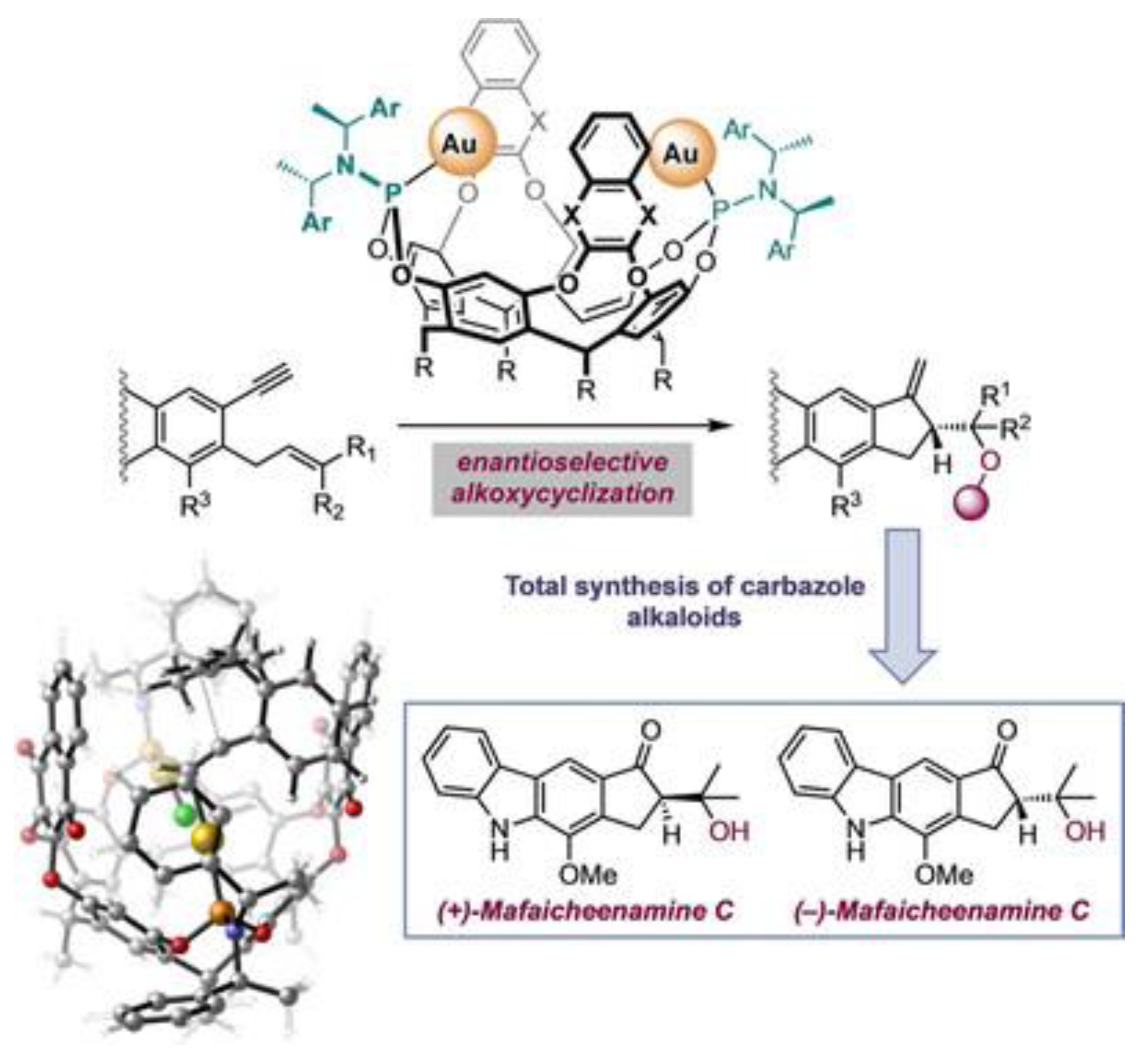


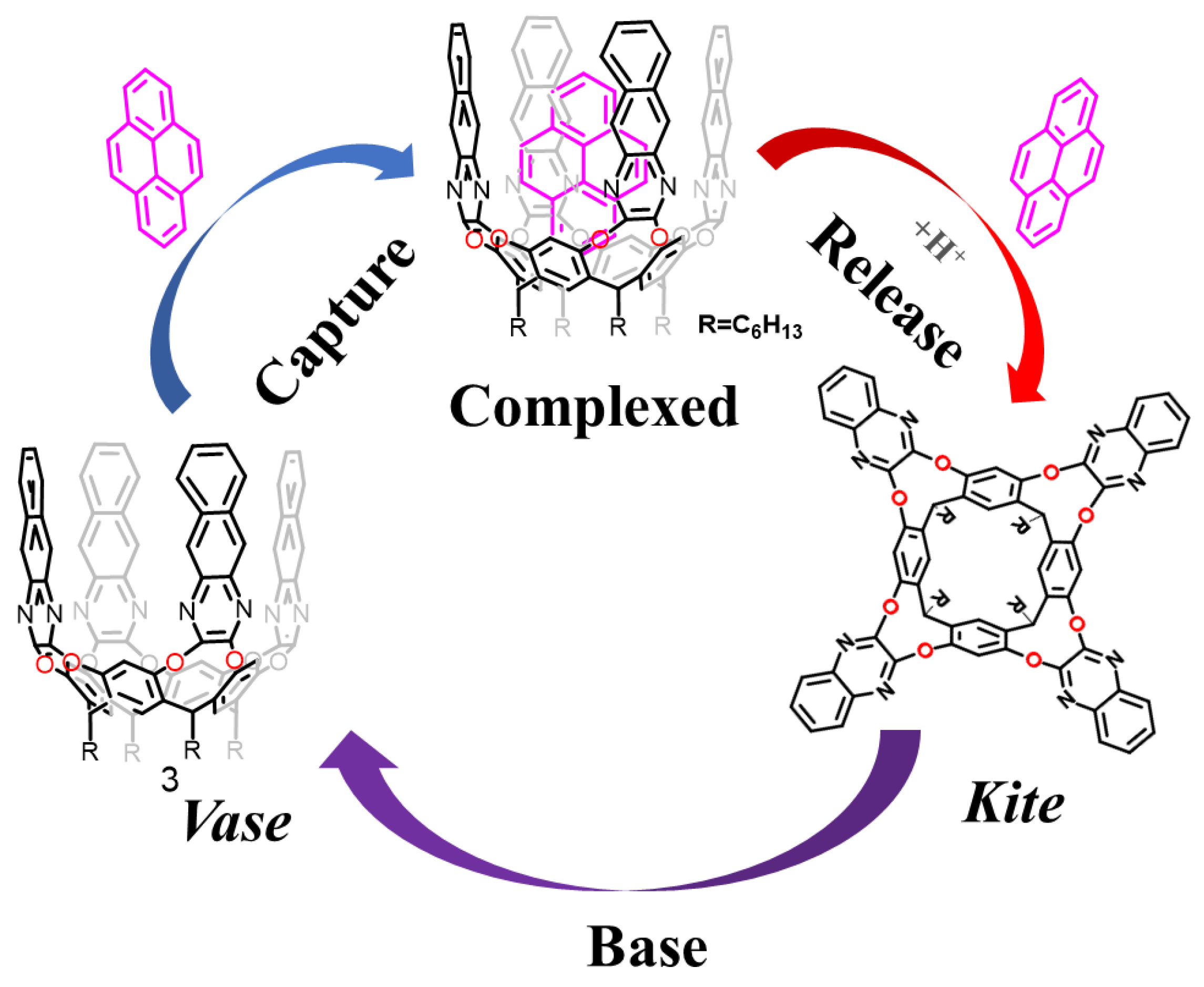

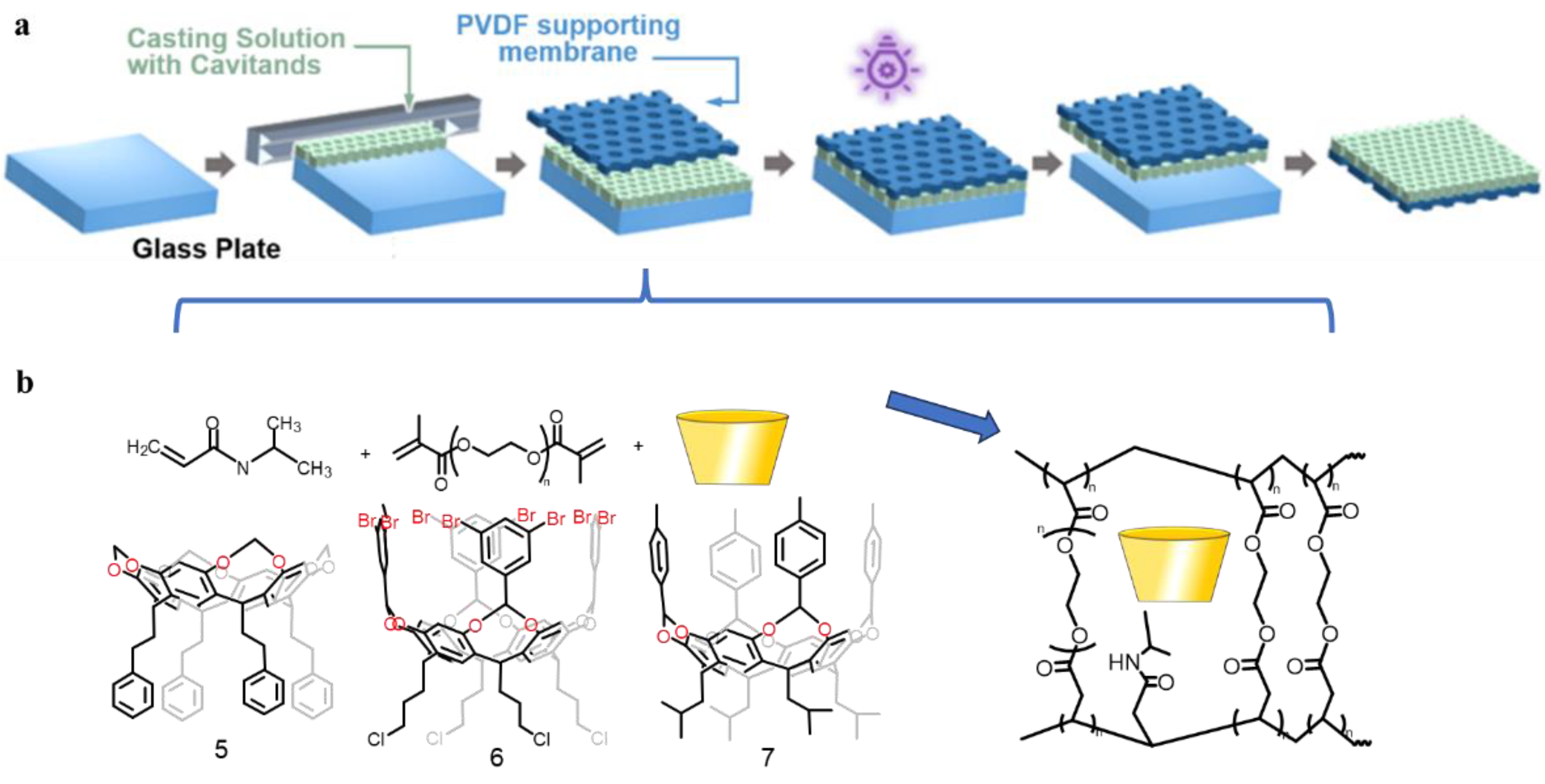


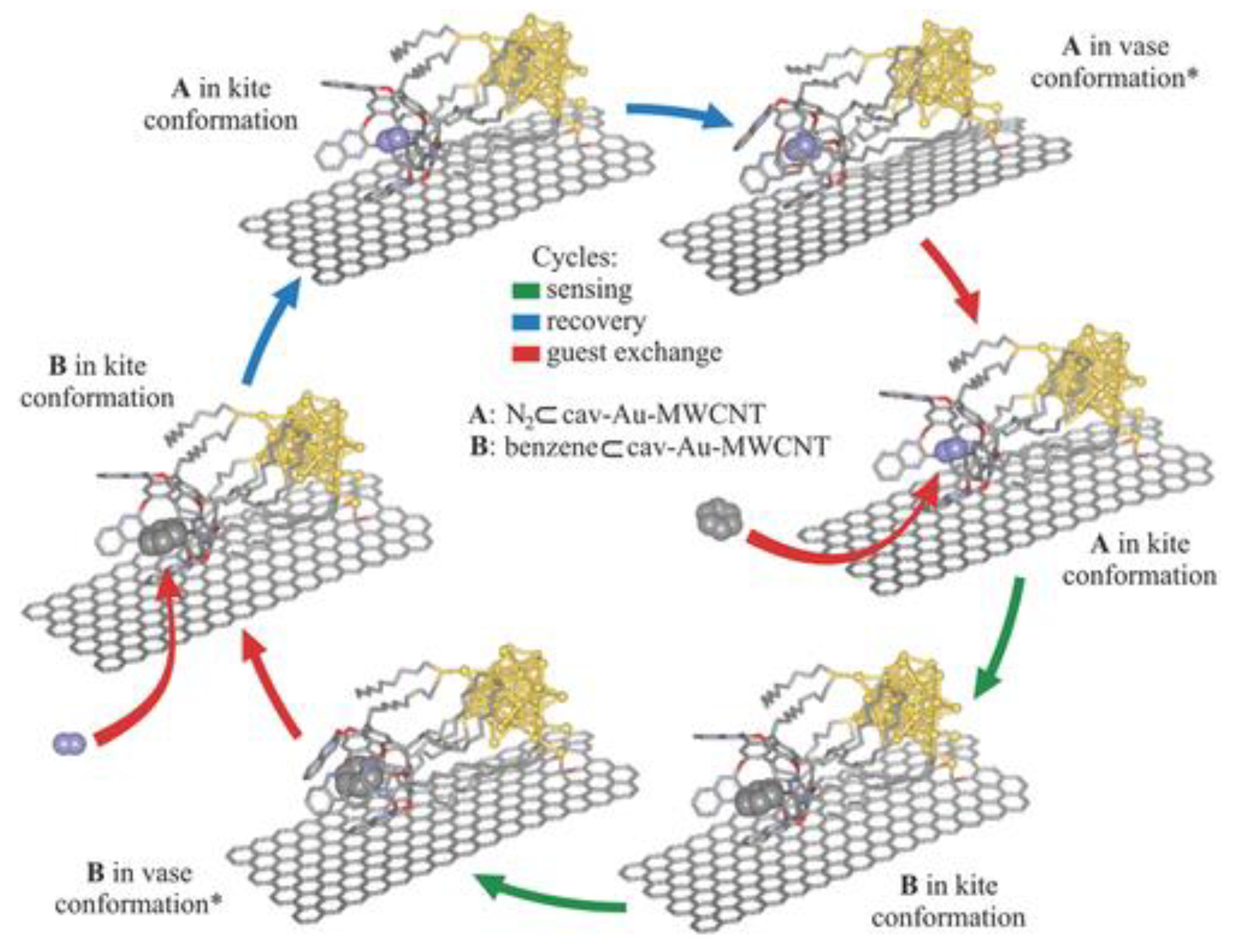
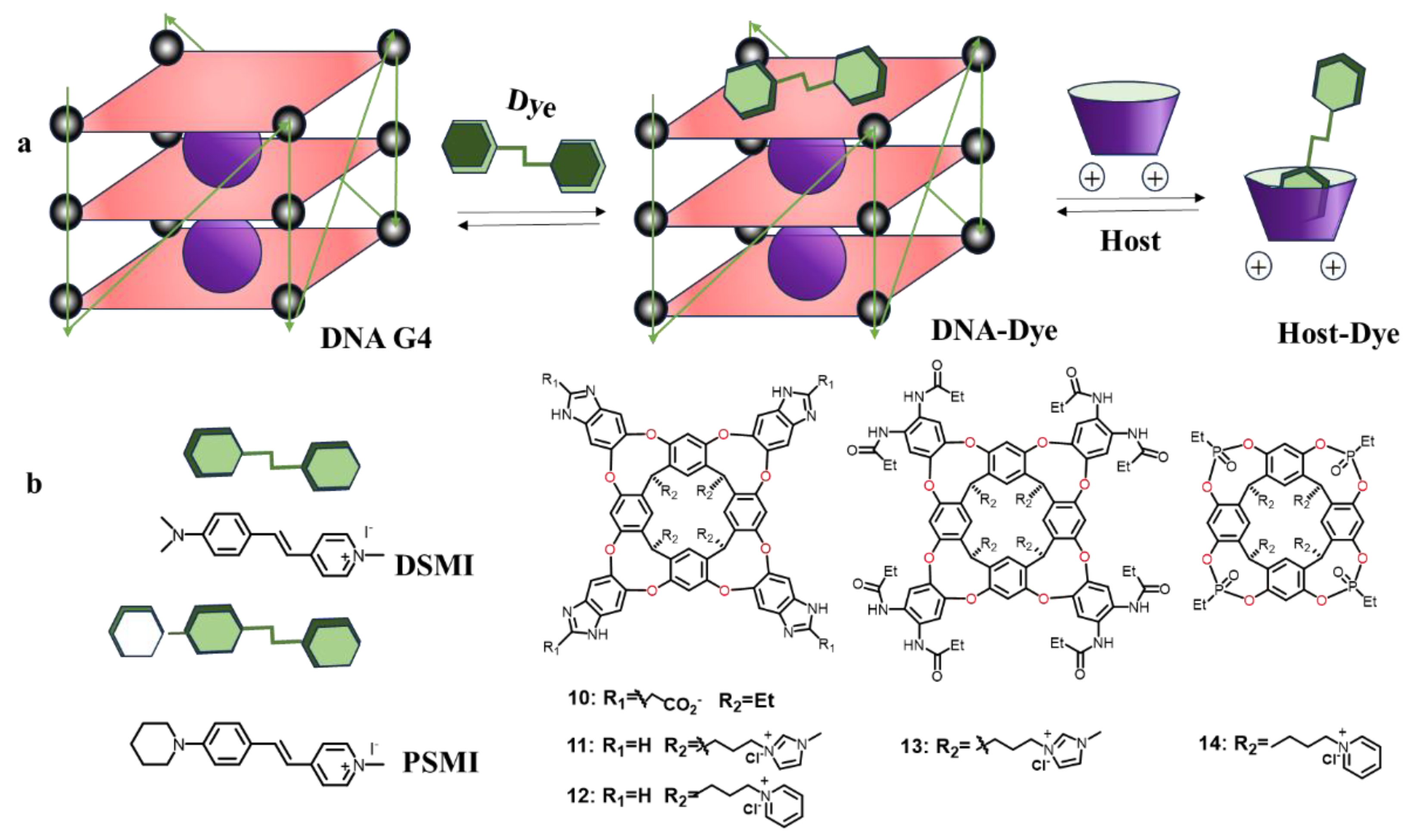
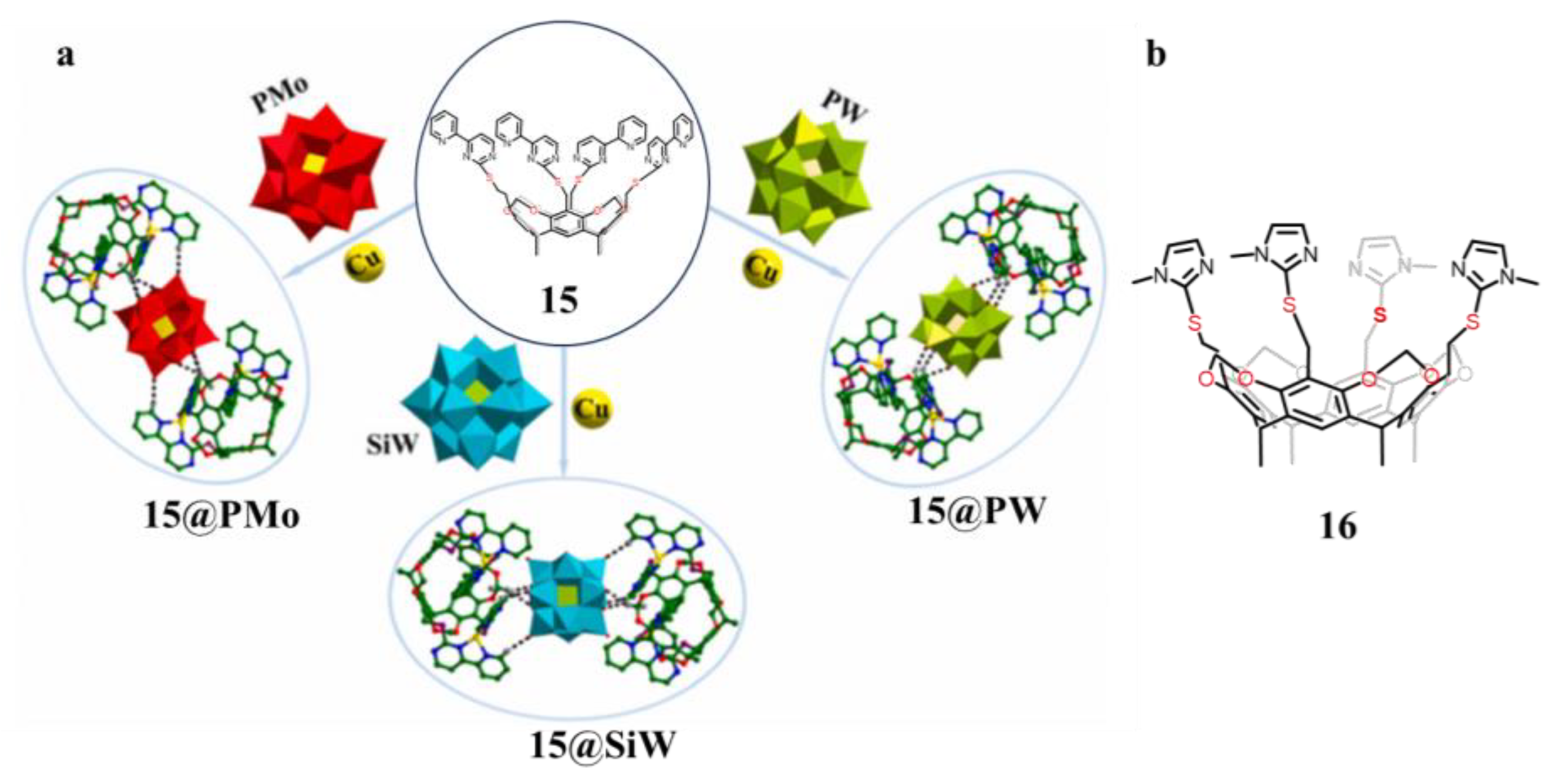

Disclaimer/Publisher’s Note: The statements, opinions and data contained in all publications are solely those of the individual author(s) and contributor(s) and not of MDPI and/or the editor(s). MDPI and/or the editor(s) disclaim responsibility for any injury to people or property resulting from any ideas, methods, instructions or products referred to in the content. |
© 2024 by the authors. Licensee MDPI, Basel, Switzerland. This article is an open access article distributed under the terms and conditions of the Creative Commons Attribution (CC BY) license (https://creativecommons.org/licenses/by/4.0/).
Share and Cite
Wang, K.; Yan, K.; Liu, Q.; Wang, Z.; Hu, X.-Y. The Versatile Applications of Calix[4]resorcinarene-Based Cavitands. Molecules 2024, 29, 5854. https://doi.org/10.3390/molecules29245854
Wang K, Yan K, Liu Q, Wang Z, Hu X-Y. The Versatile Applications of Calix[4]resorcinarene-Based Cavitands. Molecules. 2024; 29(24):5854. https://doi.org/10.3390/molecules29245854
Chicago/Turabian StyleWang, Kaiya, Kejia Yan, Qian Liu, Zhiyao Wang, and Xiao-Yu Hu. 2024. "The Versatile Applications of Calix[4]resorcinarene-Based Cavitands" Molecules 29, no. 24: 5854. https://doi.org/10.3390/molecules29245854
APA StyleWang, K., Yan, K., Liu, Q., Wang, Z., & Hu, X.-Y. (2024). The Versatile Applications of Calix[4]resorcinarene-Based Cavitands. Molecules, 29(24), 5854. https://doi.org/10.3390/molecules29245854






